Diazines and Triazines as Building Blocks in Ligands for Metal-Mediated Catalytic Transformations
- PMID: 38344013
- PMCID: PMC10853918
- DOI: 10.1021/acsorginorgau.3c00048
Diazines and Triazines as Building Blocks in Ligands for Metal-Mediated Catalytic Transformations
Abstract
Pyridine is a ubiquitous building block for the design of very diverse ligand platforms, many of which have become indispensable for catalytic transformations. Nevertheless, the isosteric pyrazine, pyrimidine, and triazine congeners have enjoyed thus far a less privileged role in ligand design. In this review, several applications of such fragments in the design of new catalysts are presented. In a significant number of cases described, diazine- and triazine-based ligands either outperform their pyridine congeners or offer alternative catalytic pathways which enable new reactivities. The potential opportunities unlocked by using these building blocks in ligand design are discussed, and the origin of the enhanced catalytic activity is highlighted where mechanistic studies are available.
© 2023 The Authors. Published by American Chemical Society.
Conflict of interest statement
The authors declare no competing financial interest.
Figures
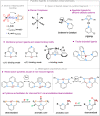

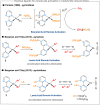


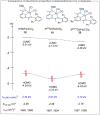




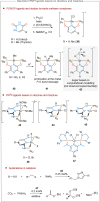

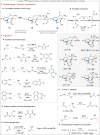

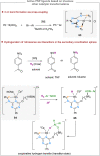
Similar articles
-
High-Symmetry Co/Ni Triazine Polycarboxylate Diverse Frameworks Constructed by Mx(COO)y Building Blocks: Characterization and Catalytic Performance Evaluation of p-Nitrophenol.Inorg Chem. 2022 Dec 12;61(49):19951-19960. doi: 10.1021/acs.inorgchem.2c03233. Epub 2022 Nov 25. Inorg Chem. 2022. PMID: 36426639
-
Effect of Building Block Transformation in Covalent Triazine-Based Frameworks for Enhanced CO2 Uptake and Metal-Free Heterogeneous Catalysis.Chemistry. 2020 Feb 3;26(7):1548-1557. doi: 10.1002/chem.201903926. Epub 2019 Dec 19. Chemistry. 2020. PMID: 31603596
-
Site Isolation in Metal-Organic Frameworks Enables Novel Transition Metal Catalysis.Acc Chem Res. 2018 Sep 18;51(9):2129-2138. doi: 10.1021/acs.accounts.8b00297. Epub 2018 Aug 21. Acc Chem Res. 2018. PMID: 30129753
-
Functionalized Triazines and Tetrazines: Synthesis and Applications.Top Curr Chem (Cham). 2022 Jun 23;380(5):34. doi: 10.1007/s41061-022-00385-7. Top Curr Chem (Cham). 2022. PMID: 35737142 Review.
-
1,3,5-Triazine-based analogues of purine: from isosteres to privileged scaffolds in medicinal chemistry.Eur J Med Chem. 2014 Oct 6;85:371-90. doi: 10.1016/j.ejmech.2014.07.112. Epub 2014 Aug 1. Eur J Med Chem. 2014. PMID: 25105925 Review.
Cited by
-
Palladium-catalyzed cascade of aza-Wacker and Povarov reactions of aryl amines and 1,6-dienes for hexahydro-cyclopenta[b]quinoline framework.Nat Commun. 2024 Aug 8;15(1):6776. doi: 10.1038/s41467-024-51173-4. Nat Commun. 2024. PMID: 39117681 Free PMC article.
References
-
-
See for example:
- Balogh J.; Hlil A. R.; Su H.-L.; Xi Z.; Bazzi H. S.; Gladysz J. A. An Analogue of Grubbs Third-Generation Catalyst with Fluorophilic Pyridine Ligands: Fluorous/Organic Phase-Transfer Activation of Ring-Closing Alkene Metathesis. ChemCatChem. 2016, 8, 125–128. 10.1002/cctc.201500913. - DOI
- Occhipinti G.; Törnroos K. W.; Jensen V. R. Pyridine-Stabilized Fast-Initiating Ruthenium Monothiolate Catalysts for Z-Selective Olefin Metathesis. Organometallics 2017, 36, 3284–3292. 10.1021/acs.organomet.7b00441. - DOI
-
-
-
The term pincer was originally introduced to refer to aryl-based meridionally coordinating tridentate, monoanionic scaffolds. Over the years, the definition of this term has been extended to include N-heterocycles and neutral scaffolds. This review uses this broad definition. For the original description, see
- van Koten G. Tuning the reactivity of metals held in a riging ligand environment. Pure Appl. Chem. 1989, 61, 1681–1694. 10.1351/pac198961101681. - DOI
-
-
- Vogt M.; Langer R. The Pincer Platform Beyond Classical Coordination Patterns. Eur. J. Inorg. Chem. 2020, 2020, 3885–3898. 10.1002/ejic.202000513. - DOI
- Merz L. S.; Ballmann J.; Gade L. H. Phosphines and N -Heterocycles Joining Forces: an Emerging Structural Motif in PNP-Pincer Chemistry. Eur. J. Inorg. Chem. 2020, 2020, 2023–2042. 10.1002/ejic.202000206. - DOI
- Peris E.; Crabtree R. H. Key factors in pincer ligand design. Chem. Soc. Rev. 2018, 47, 1959–1968. 10.1039/C7CS00693D. - DOI - PubMed
-
- Fache F.; Schulz E.; Tommasino M. L.; Lemaire M. Nitrogen-Containing Ligands for Asymmetric Homogeneous and Heterogeneous Catalysis. Chem. Rev. 2000, 100, 2159–2232. 10.1021/cr9902897. - DOI - PubMed
- Kwong H.; Yeung H.; Yeung C.; Lee W.; Lee C.; Wong W. Chiral pyridine-containing ligands in asymmetric catalysis. Coord. Chem. Rev. 2007, 251, 2188–2222. 10.1016/j.ccr.2007.03.010. - DOI
-
- Blackman A. G. Tripodal Tetraamine Ligands Containing Three Pyridine Units: The other Polypyridyl Ligands. Eur. J. Inorg. Chem. 2008, 2008, 2633–2647. 10.1002/ejic.200800115. - DOI
- Therrien B. Coordination chemistry of 2,4,6-tri(pyridyl)-1,3,5-triazine ligands. J. Organomet. Chem. 2011, 696, 637–651. 10.1016/j.jorganchem.2010.09.037. - DOI
Publication types
LinkOut - more resources
Full Text Sources
